|
Getting Started
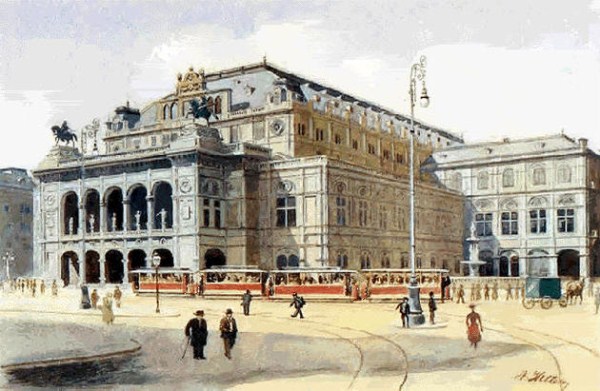
Journal One: Great Art
 Divide your paper into three columns -- statues, paintings/drawings, and buildings. Brainstorm as many specific items or artisits as you can that fit into each category as “Great Art,” certainly a subjective term. We are excluding books and music, because those are forms that can survive the destruction of the original. The words and the sounds live on in copies, not so true for physical constructs. Divide your paper into three columns -- statues, paintings/drawings, and buildings. Brainstorm as many specific items or artisits as you can that fit into each category as “Great Art,” certainly a subjective term. We are excluding books and music, because those are forms that can survive the destruction of the original. The words and the sounds live on in copies, not so true for physical constructs.
Journal Two: Three Works Worth Saving
 Think of three specific works that you think are worth saving. Write a journal which explains why each is worth saving, in your opinion. Include images of any work that might not be known to your teacher. Think of three specific works that you think are worth saving. Write a journal which explains why each is worth saving, in your opinion. Include images of any work that might not be known to your teacher.
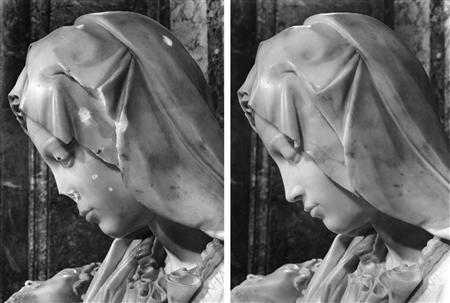
Journal Three: Vandalism
 When I was nineteen years old in 1969, I travelled with other military dependents on a roundabout journey from Newark to my parents’ duty station in Lakenheath, England. I passed through Rome, spending my time buying sandals and eating gelato, sure I would return some other day to see the art that would always be there. But on 22 May 1972, a vandal smashed The Pietà and now the restored version hides behind thick plate glass, meters from all viewers and I will never get to see what I might have seen if I had been wiser. Not war, but madness. Research and report on this single act of artistic destruction or find another of equal impact. Analyze the consequences of the act. When I was nineteen years old in 1969, I travelled with other military dependents on a roundabout journey from Newark to my parents’ duty station in Lakenheath, England. I passed through Rome, spending my time buying sandals and eating gelato, sure I would return some other day to see the art that would always be there. But on 22 May 1972, a vandal smashed The Pietà and now the restored version hides behind thick plate glass, meters from all viewers and I will never get to see what I might have seen if I had been wiser. Not war, but madness. Research and report on this single act of artistic destruction or find another of equal impact. Analyze the consequences of the act.
Research and report on this act of artistic destruction or find another of equal impact. Michelangelo’s Mona Lisa, Rembrandt’s Night Watch, Picasso’s Guernica, Al WeiWei’s $1M vase, and The Little Mermaid statue in Copenhagen harbor, among others have been attacked. Analyze the motivations and consequences of such an act.
Journal Four: And Today?

 The destruction of a nation’s cultural heritage continues today. In 2001, the Taliban systematically destroyed statues of Buddha. In August 2013, the United Nations addressed reports of looting and the destruction of monuments and museums in Egypt. Aboriginal cultures worldwide find their art at risk, even their most sacred pieces. How does the destruction of cultural identity (artwork, monuments, literature) affect a people? In addition to the historical significance, how does the loss of these items impact the identity of those it represents? The destruction of a nation’s cultural heritage continues today. In 2001, the Taliban systematically destroyed statues of Buddha. In August 2013, the United Nations addressed reports of looting and the destruction of monuments and museums in Egypt. Aboriginal cultures worldwide find their art at risk, even their most sacred pieces. How does the destruction of cultural identity (artwork, monuments, literature) affect a people? In addition to the historical significance, how does the loss of these items impact the identity of those it represents?
Journal Five: Join the Hunt

 The hunt for stolen art is not over. A recent news story revealed that more than 1,500 works supposedly destroyed by the Nazis were found in a Munch apartment on 4 November 2013. The Monuments Men Foundation website lists more information about Significant Restitutions and some of the Most Wanted Works of Art still missing. Look over these missing works and find one to research more thoroughly, summarizing what is known about its significance and its disappearance. The hunt for stolen art is not over. A recent news story revealed that more than 1,500 works supposedly destroyed by the Nazis were found in a Munch apartment on 4 November 2013. The Monuments Men Foundation website lists more information about Significant Restitutions and some of the Most Wanted Works of Art still missing. Look over these missing works and find one to research more thoroughly, summarizing what is known about its significance and its disappearance.
Lessons
On 19 March 1945, Adolf Hitler issued the Nero Decree. His intent was to destroy all infrastructure, important landmarks and communication facilities so that the advancing Allies would find nothing of value left. In the movie, this edict also includes the destruction of all the art hidden by the German army.
The Sony Educator Website has four excellent lessons and discussion questions --
“The thought came back to him, as it often did: To save the culture of your allies is a small thing. To cherish the culture of your enemy, to risk your life and the life of other men to save it, to give it all back to them as soon as the battle was won…it was unheard of, but that was exactly what Walker Hancock and the other Monuments Men intended to do.”
|
|
The Texts
Several books are relevant to research on this subject.
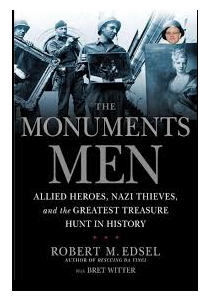 The Monuments Men: Allied Heroes, Nazi Thieves and the Greatest Treasure Hunt in History by Robert M. Edsel. The Monuments Men: Allied Heroes, Nazi Thieves and the Greatest Treasure Hunt in History by Robert M. Edsel.
As Hitler was attempting to conquer the western world,
his armies were methodically pillaging the finest art in Europe, from Michelangelo and Da Vinci to Van Eycks
and Vermeers, all stolen for the Führer. Excerpt.
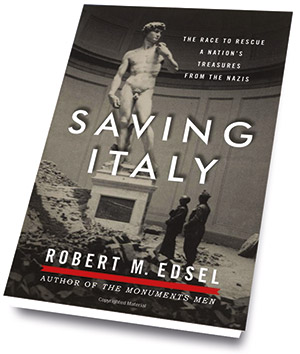
Saving Italy: The Race to Rescue a Nation's Treasures from the Nazis by Robert M. Edsel. Brilliantly researched and vividly written, Saving Italy brings readers from Milan and the near destruction of The Last Supper to the inner sanctum of the Vatican and behind closed doors with the preeminent Allied and Axis leaders: Roosevelt, Eisenhower, and Churchill; Hitler, Göring, and Himmler. Exerpt.
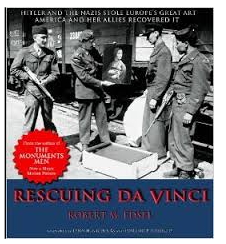 Rescuing Da Vinci: Hitler and the Nazis Stole Europe’s Greatest Art - America and Her Allies Recovered It by Robert M. Edsel. Told through 460 photographs, a group of 345 men and women from thirteen nations tracked, located, and ultimately returned more than 5 million artistic and cultural items stolen by Hitler and the Nazis. Rescuing Da Vinci: Hitler and the Nazis Stole Europe’s Greatest Art - America and Her Allies Recovered It by Robert M. Edsel. Told through 460 photographs, a group of 345 men and women from thirteen nations tracked, located, and ultimately returned more than 5 million artistic and cultural items stolen by Hitler and the Nazis.
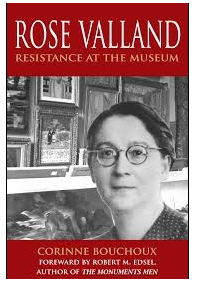 Rose Valland: Resistance at the Museum by Corinne Bouchoux. Rose Valland is one of the greatest and yet unknown heroines of World War II. After risking her life spying on the Nazis, day after day for four long years, Rose lived to fulfill her destiny: locating and returning tens of thousands of works of art stolen by the Nazis during their occupation of France. Exerpt. Rose Valland: Resistance at the Museum by Corinne Bouchoux. Rose Valland is one of the greatest and yet unknown heroines of World War II. After risking her life spying on the Nazis, day after day for four long years, Rose lived to fulfill her destiny: locating and returning tens of thousands of works of art stolen by the Nazis during their occupation of France. Exerpt.
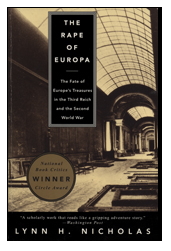 The Rape of Europa: The Fate of Europe's Treasures in the Third Reich and the Second World War by Lynn H. Nicholas is a book and a subsequent documentary film. It explores Nazi appropriation and storage, patriotic concealment and smuggling during World War II, discoveries by the Allies, and the extraordinary tasks of preserving, tracking and returning by the American Monuments officers and their colleagues. The Rape of Europa: The Fate of Europe's Treasures in the Third Reich and the Second World War by Lynn H. Nicholas is a book and a subsequent documentary film. It explores Nazi appropriation and storage, patriotic concealment and smuggling during World War II, discoveries by the Allies, and the extraordinary tasks of preserving, tracking and returning by the American Monuments officers and their colleagues.
|
|

Best Sites
Monuments Men Foundation honors the legacy of the men and women who served in the Monuments, Fine Arts, and Archives section .
The Sony Pictures site includes interactive games on decoding, map restoration and discerning forgeries. They also have lesson plans, links to museums, and discussion questions.
Monuments Men at the Met: Treasures Saved During World War II is an interactive tour of works in the New York Metropolitan Museum of Art that were saved by the MFAA. It has an interactive tour, with information about provenance and recovery. There is also a series of photographs and journals documenting the work of many who were affiliated with the Met.
The Smithsonian’s The True Story of the Monuments Men offers an introduction to the story. Even better, its more academic Monuments Men: On the Front Line to Save Europe’s Art, 1942-1946 is an amazing site provided by the Smitsonian. It includes primary sources, including audio interviews, documents, any photographs, each with in-depth explanations. Especially useful for further research are a serious of eight podcasts, with full transcripts.
The Monuments Men YouTube Channel collects contemporaneous newsreeeal and other archival footage about the group. Sponsored by the Foundation, it also includes more recent interviews. The Merkers Salt Mine Discovery, Neuschwanstein, and General Eisenhower at the Met are especially interesting. |


 The Monuments Men: Allied Heroes, Nazi Thieves and the Greatest Treasure Hunt in History by Robert M. Edsel.
The Monuments Men: Allied Heroes, Nazi Thieves and the Greatest Treasure Hunt in History by Robert M. Edsel.
 Rescuing Da Vinci: Hitler and the Nazis Stole Europe’s Greatest Art - America and Her Allies Recovered It by Robert M. Edsel. Told through 460 photographs, a group of 345 men and women from thirteen nations tracked, located, and ultimately returned more than 5 million artistic and cultural items stolen by Hitler and the Nazis.
Rescuing Da Vinci: Hitler and the Nazis Stole Europe’s Greatest Art - America and Her Allies Recovered It by Robert M. Edsel. Told through 460 photographs, a group of 345 men and women from thirteen nations tracked, located, and ultimately returned more than 5 million artistic and cultural items stolen by Hitler and the Nazis. Rose Valland: Resistance at the Museum by Corinne Bouchoux. Rose Valland is one of the greatest and yet unknown heroines of World War II. After risking her life spying on the Nazis, day after day for four long years, Rose lived to fulfill her destiny: locating and returning tens of thousands of works of art stolen by the Nazis during their occupation of France.
Rose Valland: Resistance at the Museum by Corinne Bouchoux. Rose Valland is one of the greatest and yet unknown heroines of World War II. After risking her life spying on the Nazis, day after day for four long years, Rose lived to fulfill her destiny: locating and returning tens of thousands of works of art stolen by the Nazis during their occupation of France.  The Rape of Europa: The Fate of Europe's Treasures in the Third Reich and the Second World War by Lynn H. Nicholas is a book and a subsequent documentary film. It explores Nazi appropriation and storage, patriotic concealment and smuggling during World War II, discoveries by the Allies, and the extraordinary tasks of preserving, tracking and returning by the American Monuments officers and their colleagues.
The Rape of Europa: The Fate of Europe's Treasures in the Third Reich and the Second World War by Lynn H. Nicholas is a book and a subsequent documentary film. It explores Nazi appropriation and storage, patriotic concealment and smuggling during World War II, discoveries by the Allies, and the extraordinary tasks of preserving, tracking and returning by the American Monuments officers and their colleagues.